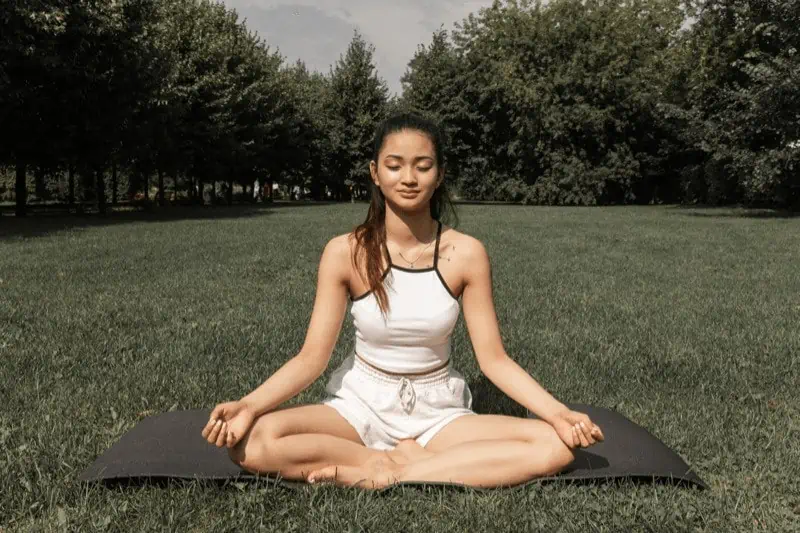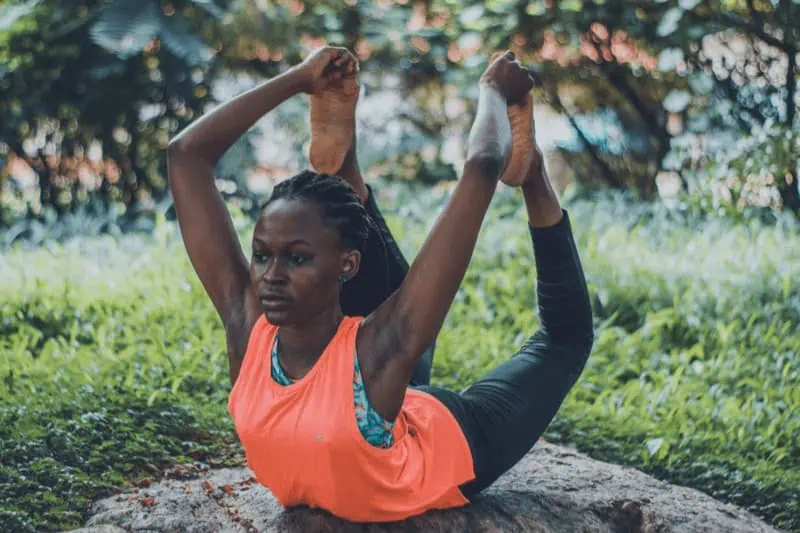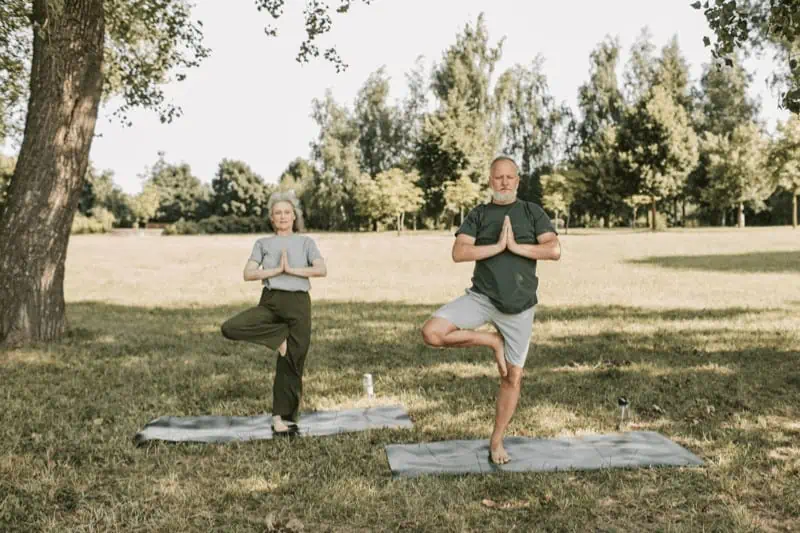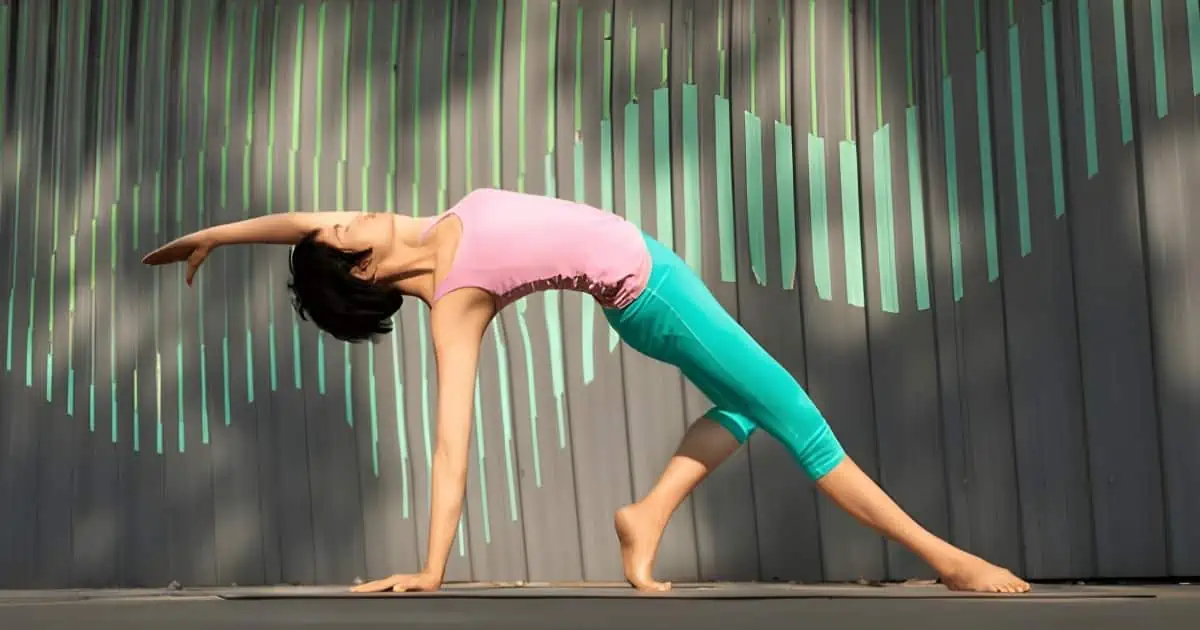Key Takeaway
Asana yoga transcends physical exercise, offering a holistic approach to balance and harmony in life; it is a foundational step in the yoga journey that enriches body, mind, and spirit.
For new yogis, the first question they may ask their teacher is, “What is an asana?” From a yoga teacher’s perspective, I would answer that an asana can be many things: often, people equate asanas and yoga as the same thing. However, the yoga postures we use during a class are just one small part of yoga.
In today’s physical culture, we tend to place significant focus on the body’s abilities as a way to define health. But asana yoga practice transcends mere physical exercise. It adapts the ancient wisdom of yoga traditions to our modern existence, offering a way to cultivate balance and harmony in life.
To grasp the meaning of asana yoga, we need to know the technical definition of the word asana while also understanding its purpose within the whole system and history of yoga.
Join me on this exploration as we answer the question, “What is asana?” Along the way, I’ll share my insights demonstrating the significance of asanas as a foundational step in one’s yoga journey.
Contents
- 1 Understanding Asana in Yoga
- 2 Tracing the Historical Roots of Asana in Yoga
- 3 Exploring the Diversity of Yoga Postures and Their Therapeutic Effects
- 4 The Role of Yoga Asana in Spiritual and Emotional Well-being
- 5 Unveiling the Benefits of Regular Yoga Asana Practice
- 6 Conclusion
- 7 Frequently Asked Questions
Understanding Asana in Yoga
This term is a foundational step of the yoga tradition. It refers to the third limb of the Eightfold Path of yoga and, more specifically, to various physical positions that practitioners adopt during a yoga sequence.
What Is an Asana
An asana is a yoga posture. There are many different types of asanas, and each one is unique. They may focus on balance, muscle tone, flexibility, energy, or stress relief.
- In the context of yoga, “asana” is not just about holding a position but also about maintaining focused concentration and awareness while in that position.
- Typically, yoga teachers direct their students through proper breathing techniques paired with specific asanas to enhance the benefits of the yoga postures.
Where Does the Word Asana Come From?
The term “asana” comes from Sanskrit, the ancient language of India. In English, “asana” translates to “pose,” “posture,” or “seat.” Many yoga teachers use the words asana, pose, and posture interchangeably.
Have you attended a yoga class where the teacher used the traditional Sanskrit names for the postures? If so, you might have noticed a pattern. Every yoga pose name in Sanskrit ends with the suffix “-asana.” For example:
- Bala (child) + asana = Balasana or Child’s Pose
- Trikona (triangle) + asana = Trikonasana or Triangle Pose
- Baddha (bound) + kona (angle) + asana = Baddha Konasana or Bound Angle Pose
Including “asana” in the Sanskrit names of yoga poses lets you know that the term refers to a yoga posture. This convention holds for all Sanskrit yoga pose names.
Tracing the Historical Roots of Asana in Yoga
In today’s physical culture, asanas, or yoga postures, are usually the focus of modern yoga practice. Their origins and evolution are rooted in ancient traditions and texts and medieval hatha yoga practices, and they significantly evolved throughout the 20th century.
Original Meditation Posture
The earliest asana was a seat for meditation. It served as a stable base for long periods of stillness. Comfort and ease were vital to helping the mind focus on each breath, paving the way for a more centered practice over time.

Emergence in Yoga Sutras
The first mention of asanas appears in the Yoga Sutras. Written sometime between the 2nd century BCE and the 4th century CE, this text refers to posture as a tool for meditation. The Yoga Sutras make little mention of asanas, as the text mainly emphasizes yoga’s mental and spiritual purpose.
The most well-known verse of the Yoga Sutras regarding asanas is brief yet clearly states yoga’s primary goal and gives the practitioner a clear direction:
This passage still serves as the foundation for asana practice. In fact, it was the first of the Yoga Sutras I learned in my yoga teacher training.
Texts Defining Asanas
Through the following centuries, Hatha yoga developed to include more positions, which still intended to prepare the body for sitting meditation. Here are some notable yogic texts that expanded the collection of asanas we recognize today.
- The Hatha Yoga Pradipika, a 15th-century yogic text, detailed 15 basic asanas: 7 seated postures and 8 non-seated. It mentions others in lesser detail, totaling 84 asanas.
- In the 17th century, the yogic texts Gheranda Samhita and Shiva Samhita provided further direction for practicing the basic asanas.
- The Yoga Makaranda, published in 1934 by the “father of modern yoga,” T. Krishnamacharya, introduced many asanas that provided the foundation for all modern styles of yoga.
- Krishnamacharya’s student B.K.S. Iyengar contributed the most comprehensive instructional yogic text with his 1966 book Light on Yoga. It provides detailed direction of alignment and form for 200 postures and 600 photos of Iyengar demonstrating the asanas.
The more recent 20th-century texts also describe the many health benefits of specific yoga poses, explaining their positive effects on the human system, bringing ease and comfort to the physical body and mind.
Tradition Across Centuries
Over time, the number of yoga poses grew significantly. Teachers like Iyengar emphasized alignment and precision. This attention to detail in Iyengar yoga transformed how we view and practice Hatha yoga asanas and poses today.
Another of Krishnamacharya’s star students, Pattabhi Jois, arranged a set sequence of 49 asanas — the Ashtanga Primary Series — which gained popularity and helped spread yoga throughout the Western world.
Yoga traditions began with a spiritual purpose but adapted significantly throughout the 20th century to include a focus on physical exercise. But at its heart, asana practice is not just exercise; it’s also about channeling energy effectively.
Importance of Asana History
You don’t have to be a yoga scholar to find value in yoga’s fascinating history. Even before I was a yoga teacher, in my experience with Hatha yoga practice, I found that learning from the perspective of teachers like Iyengar enriched my understanding of each pose or asana.
Knowing a bit about the history of yoga and its recent development has also deepened my appreciation for the whole system of yoga and how it has evolved to serve the needs of modern practitioners. Reading or listening to insights from present-day masters such as Sadhguru can deepen your connection to your favorite yoga poses.
Exploring the Diversity of Yoga Postures and Their Therapeutic Effects
Yoga postures, or asanas, offer a wide range of health benefits through each meticulously aligned pose. They have evolved over time, from a traditional set of postures to a vast array of poses that range in style, category, and intention. For example:
- Hatha yoga emphasizes the importance of these poses for creating balance in the body’s whole system, physically, mentally, and spiritually.
- Iyengar yoga focuses attention on alignment, especially of the spine. It is common to use modifications and props in this style of yoga to maintain proper form.
Various Asana Categories
Yoga began with simple seated postures geared toward meditation. Within the vast collection of modern postures, there are many different ways to categorize asanas. Most often, you’ll find them divided into categories based on body position:
- Seated
- Standing
- Supine (lying on the back)
- Prone (lying face-down)
- Kneeling
- Forward bends
- Backbends
- Balancing
- Twists
- Arm balance
- Inversions
Note that many asanas fit under multiple categories. For example, Uttanasana (Forward Fold) is a standing, forward-bending asana. Dhanurasana (Bow Pose) is a prone back-bending posture.

Asana categories can vary depending on the teacher, style, or tradition. Thinking of asanas in this way helps yoga teachers plan intentional and creative classes to fit their students’ needs. Here are some things I’ve used in preparing my own yoga classes:
- Targeted muscle group: postures that stretch the hamstrings or open the hips
- Intention: poses to build strength, release tension, or produce restorative effects
- Energy: asanas that focus on a specific chakra
- Therapeutic health benefits: poses that aid digestion or relieve back pain
Asanas and Body Systems
Different asanas benefit various body systems. For example, twists aid digestion, while backbends open the chest and enhance respiratory function. Forward folds calm the nervous system, and balancing poses build mental concentration. Each posture supports the body in its distinct way.
An Asana of Great Importance
As a yoga teacher, I always stress to my students the importance of spending time in Savasana or Corpse Pose at the end of a yoga session. I’ve found a lot of students, pressured by the demands of our fast-paced world, feel tempted to skip this restful posture.
However, most yoga teachers agree that Savasana is the most crucial asana of all! It gives your whole system time to integrate and absorb all the positive effects of your yoga session. It allows you to rest in a meditative state, calming your mind before you jump back into your busy life off the yoga mat.
The Role of Yoga Asana in Spiritual and Emotional Well-being
It’s well-documented by science that physical exercise can support emotional health by releasing endorphins in the brain. The same is true for practicing asanas. However, when you practice yoga postures with focus and intention, the experience can be much more profound.
At their core, asanas serve a spiritual purpose; they are parts of the greater yoga philosophy system that enriches and brings harmony to your life. Think of asanas as the tools you use to create balance within each aspect of yourself — body, mind, and spirit.
Spiritual Growth Through Asana
Regular physical practice of asanas creates a kind of ritual in your life, similar to many religious practices. As a yoga teacher, I’ve had people question whether yoga is a religion. It isn’t, but if you practice intentionally, you may experience profound personal growth similar to other spiritual practices.
Here are some things I’ve noticed in my personal life as a direct result of my dedicated yoga practice.
- Clearer sense of identity through self-reflection and introspection
- More peaceful state of mind
- Stronger sense of connection to all living beings
- Greater compassion for others
- Feeling secure in personal values
Mind-Body-Spirit Balance
The balance achieved through asana practice is profound. When you learn to align your breath with movement, you harmonize life’s rhythm. Achieving inner peace and a meditative state is much easier when the body is at ease.
So often today, people go through the motions of existence, running from one place to the next with no work-life balance. When you set aside time to practice yoga asana regularly, you can restore your sense of ease.

Unveiling the Benefits of Regular Yoga Asana Practice
Yoga asana practice is more than physical exercise. It’s a way to balance body and mind. A growing body of science proves yoga asana’s physical and mental benefits.
Positive Physical Health Effects
Over time, people who engage in consistent asana practice notice improvements in overall physical health, including:
- Stronger, toned muscles
- Increased flexibility
- Improved balance
- Enhanced immune function
- Reduced back pain and body aches
- Better sleep
- Improved posture and general mobility
- More efficient blood circulation and respiration
- Relieves stress symptoms by lowering pulse rate and slowing breathing
At a time in my life when I used to commute for work, practicing yoga asana was a godsend for my physical body. I remember arriving home in pain after being stuck in my vehicle for an hour or more each day. Incorporating a few specific asanas into my daily routine was a small change that made a massive difference for me.
Mental Health Benefits
Another reason to keep practicing yoga asana is the significant mental health perks. Some of these things include:
- Improved concentration and brain function
- Reduced anxiety, better stress management
- Increased mindfulness
- Improved, more stable mood
- Greater resilience and coping skills
- Increased self-awareness and improved personal relationships
For people like me who juggle multiple responsibilities daily, moving through some yoga postures can provide a way to calm the body and mind, enhancing decision-making abilities.
Conclusion
Ultimately, the question, “What is asana?” has a simple and profound answer. At the surface level, an asana is a yoga posture — an intentional position the body forms during a yoga class. Within the whole system of yoga, asanas are one step on a journey to self-discovery and personal growth.
To be even more specific, asanas can be many things: physical exercise, a way to improve health, a tool to bring peace of mind, and so much more.
I urge you to embrace asana yoga with both curiosity and dedication. Incorporating these ancient techniques into your daily routine allows you to embark on a transformative journey toward a more harmonious state of being.
To start your path to wellness with yoga today, you can explore many asanas with our detailed pose guides or jump into some free online yoga classes with Yogadownload.com.
Frequently Asked Questions
What is an asana in yoga?
An asana is a physical posture or pose in yoga designed to improve strength, flexibility, balance, and mental focus.
What does “asana yoga” mean?
Asana yoga refers to the third limb of yoga, the physical practice of yoga postures.
How many asanas are there in yoga?
There is no set number of asanas, as the practice continuously evolves. However, some people would say the answer is 84 asanas (according to yoga tradition and classic Hatha yoga texts). In modern practice, the number of poses might be around two hundred.
Is asana yoga suitable for all ages?
Absolutely. Various poses can be adapted to each individual’s fitness level and flexibility. Children, adults, and seniors can all benefit from yoga practice, though it’s essential to choose the right type of class and asanas according to one’s physical capabilities and health condition.
Do I need special equipment to practice asana yoga?
The only essential equipment for practicing asana yoga is a yoga mat, which provides cushion and prevents slipping. However, other props, such as blocks, straps, and bolsters, can be helpful for beginners or those with limited flexibility, as they provide alignment support and physical comfort.
How often should I practice asana yoga for the best results?
For the best results, I recommend practicing asana yoga regularly. Most practitioners find that doing yoga several times a week helps them become stronger, more flexible, and more relaxed.







